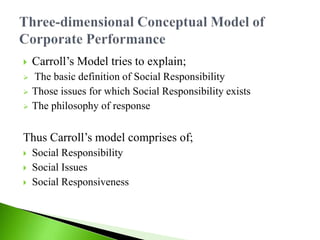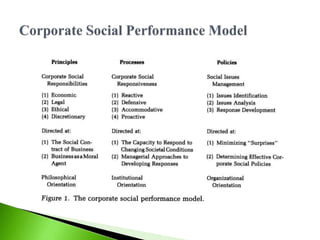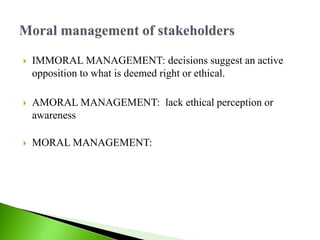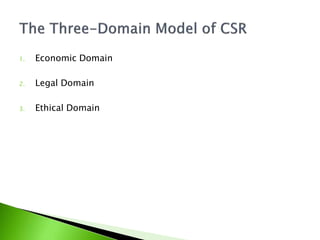Criticism on Carroll's Model
- 1. Muhammad Taimur Mustafa Shams Ud din Nighat Saif
- 2. Carroll’s Model tries to explain; The basic definition of Social Responsibility Those issues for which Social Responsibility exists The philosophy of response Thus Carroll’s model comprises of; Social Responsibility Social Issues Social Responsiveness
- 3. “The social responsibility of business encompasses the economic, legal, ethical, and discretionary expectations that society has of organizations at a given point in time”
- 4. Carroll’s Model identifies issues or areas to which social responsibility is directed Consumerism, Environment, Discrimination, Product safety, occupational safety and shareholders Changes in social issues with respect to time Changes in social issues with respect to industry
- 5. The capacity of a corporation to respond to social pressure The strategy behind business response to social responsibility and social issues Relates with the degree and kind of managerial actions Includes Reaction, Defense, Accommodation and Proaction.
- 7. The CSP Model is unique as; It integrates Economic and Public responsibilities into Social responsibility It reflects the interaction among responsibility, responsiveness and social issues However, Carroll’s work fails to provide the Model’s dynamic evolution And fails to consider the process of analysis, debate and modifications.
- 8. Three basic challenges; 1. Economic Responsibility 2. Public Responsibility 3. Social Responsiveness
- 9. The Criticism: Economic responsibility is the firm’s single responsibility Corporations cannot be Moral Agents The Response: Corporations are no more just “Earning machines” They are politically involved and are required to be socially active
- 10. The Criticism: Corporations have two involvements, Economic task and its consequential effects Public Responsibility recognizes both of them Social Responsibility is a vague, ambiguous and ill-defined concept Social Responsibility should be replaced by Public Responsibility
- 11. The Response: Public Responsibility is not different than Social Responsibility In the broader context “widely shared and acknowledged principles of society or public opinion, emerging issues, formal law and enforcement practices” it is same as social responsibility In the narrower view its too restrictive in the scope of CSR
- 12. The Criticism: Social Responsibility is operationally dysfunctional Social Responsibility lacks to determine what’s to be done, how much to be done. It used to be social obligation, then social responsibility and now evolved into social responsiveness Social responsiveness (capacity of corporations to respond to social issues) is more tangible and achievable Thus Social responsiveness should substitute social responsibility
- 13. The Response: Social Responsiveness is a valid concept but not a substitute for social responsibility. Social Responsibility determines business ethics while social responsiveness deemphasizes it Social responsiveness is a reactionary step What about ethical problems and social irresponsibility without awareness, pressure and outcry? Social responsibility as a guide for corporation’s activities
- 14. Corporate Social Performance accepts the importance of economic responsibility McGuire (1963), Carroll (1979), Strand (1983), Zenisek (1979), Ducker (1984) CSP model includes Public Responsibility within social responsibility Carroll (1979), Strand (1983) CSP model considers both social responsibility and social responsiveness as valid Carroll argues that both play different roles in CSP
- 15. Another dimension to Carroll’s model It reduces surprises due to unpredictable and dynamic business environment It includes a) issue identification b) issue analysis and c) response development The final dimension to CSP An extension of social responsiveness A method for operationalizing social responsiveness
- 17. Defining corporate social performance: Sethi (1979) offered categories of CSP not definition. Concise definition by Carroll (1979) in favor of a three dimensional model. Ullmann (1985) showed need for a theory of CSP. Wartick and Cochran (1985) based on Carroll work defined CSP model as “the underlying interaction among the principles of social of social responsibility, the process of social responsiveness and the policies developed to address social issues”.
- 18. Wartick and Cochran’s Model intended to account ◦ Motivating principles ◦ Behavioral processes ◦ Observable outcomes A business organization's configuration of principles of social responsibility, processes of social responsiveness, and policies, programs and observable outcomes as they relate to the firm’s social relationships.
- 19. Institutional Principle: Legitimacy Organizational principles: Public responsibility Individual Principle: Managerial Discretion. Wartick and Cochran argued that Carroll's four categories represented principles of social responsibility; the first element of CSP.
- 20. Principle of legitimacy: society has right to establish and enforce a balance of power among its institutions and to define legitimate functions. Principle of public responsibility: it is organization’s responsibility to act affirmatively for social well being. Principles of managerial behavior: individual’s right and responsibility to decide and act are affirmed within bounds of economic, legal and ethical constraints.
- 21. Fredrick “the capacity of corporations to respond to social pressures” Sethi (1979) Responsiveness could be seen as a replacement of CSR Carroll (1979) Responsiveness is conceptually inadequate to replace CSR. Watrick and Cochran (1985) within CSP model, responsiveness compliments but does not replace responsibility. Used Carroll’s reactive, defensive, accommodative and proactive to represent the process of social responsiveness.
- 22. Environmental Assessment: Stakeholder Management Issues Management The three facets of responsiveness environmental assessment (Context), stakeholders management (actors) and issues management (interests) are inter locked.
- 23. Social Impacts of Corporate behavior: Corporate Social programs and Policy Policies developed by companies This third part of CSP model is actually observable and where real performance exists
- 24. The reformulation of CSP model in this article gives following conceptual advances: Articulation of principles of CSR at institutional, organizational and individual level. Identification of specific responsive processes i.e. environmental assessment, stakeholder management and issues management. Incorporating social impact, policies and programs as collective outcomes.
- 26. Four aspects of CSR are linked Corporate stakeholders: view changed from what are responsibilities to whom organizations are responsible Presented idea of CSR pyramid
- 27. Stakeholders are prioritized Criteria 1) Legitimacy 2)power
- 28. Philanthropic Responsibilities Be a good corporate citizen. Ethical Responsibilities Be ethical. Legal Responsibilities Obey the law. Economic Responsibilities Be profitable.
- 29. IMMORAL MANAGEMENT: decisions suggest an active opposition to what is deemed right or ethical. AMORAL MANAGEMENT: lack ethical perception or awareness MORAL MANAGEMENT:
- 30. MarkS . Schwartz Archie B . Carroll
- 32. 1. Issues or limitations of Carroll's model 2. New alternative model, the "Three-Domain Model of CSR“
- 33. Use of a Pyramid Framework Use of a Separate Philanthropic Category Incomplete Development of Economic, Legal, and Ethical Domains
- 34. 1. Economic Domain 2. Legal Domain 3. Ethical Domain
- 36. Thank You!!!
Editor's Notes
- These four categories are not mutually exclusive, nor are they intended to portray a continuum with economic concerns on one end and social con-cerns on the other. That
- Instead of arguing that economic and Public policy responsibilities are inconsistent with Social responsibilities (friedman 62, hynes 68) Responsibility, responsiveness and issues are separate alternative corporate concerns (friedrick 78, Murphy 78, Sethi 79)
- these challenges are not merely supporting the social responsibility rather it tried to target the scope of social responsibility and performance criteria of managers.
- Stockholders are the real owners, they deserve financial returns. Spending from their earnings is more or less levying taxes on the corporation. thus social responsibility is a subversive theme in social contract. Also Corporations can't be moral agents. People can do social spendings from their personal income and thus social responsibility other than wealth maximization is not fair on ethical ground too. Response Corporations are no more only "earning machines". they have got other responsibilities too. they've got political as they are involved in lobbying, creating political action communities and submitting congressional testimony. this political involvement requires them to be add social dimensions like Equal opportunity, wok safety, environment to stay in the business. Thus saying only economic responsibility is what corporation should seek is myopic
- Social responsibility is ambiguous, vague and ill defined. its not concrete while dealing with conflicts b/w corporate goals and social issues. it does not clarify the boundary between the genuine responsibilities of business and the overall activities in the society.
- it fails to address many issues faced by corporations in social policy).
- Social responsibility is operationally dysfunctional. Social responsibility lacks to determine the content of whats to be done, how much to be done. Social responsibility underlies the conscience of executives, the costs of forgone profits and voluntary discretion and all of these are hard to assess thus S/R is ambiguous. corporate social involvement has evolved. According to Sethi it used to be social obligation then social responsibility and now social responsiveness. Murphy says that it used to be philanthropy, then awareness development (S/R) , then issue emphasis and now Social responsiveness. social responsiveness (capacity of corporations to respond to social issues) is more tangible, achievable and is thus a replacement of social responsibility,
- 5. In the absence of this guide, corporations will face loads of societal demands which will not be possible to meet
- McGuire: social responsibility includes economic responsibility but much more than that. Carroll(79) and Strand (83) includes economic responsibility as basic underlying principle of their model Zenisek (79) proposes economic as 1st and social as 4th layer of managerial responsibility and thus are not trade offs but components of overall societal responsibility. Ducker (84) said firm is responsible for capital formation and profit but other responsibilities should not be excluded from considerations just because they reduce profits. In Strand's model public responsibility is implicit in his category of "social demands and expecta-tions placed on organizations Carroll legal component includes it in narrow and discretionary includes it in broader sense. In Strand's model public responsibility is implicit in his category of "social demands and expectations placed on organizations




































